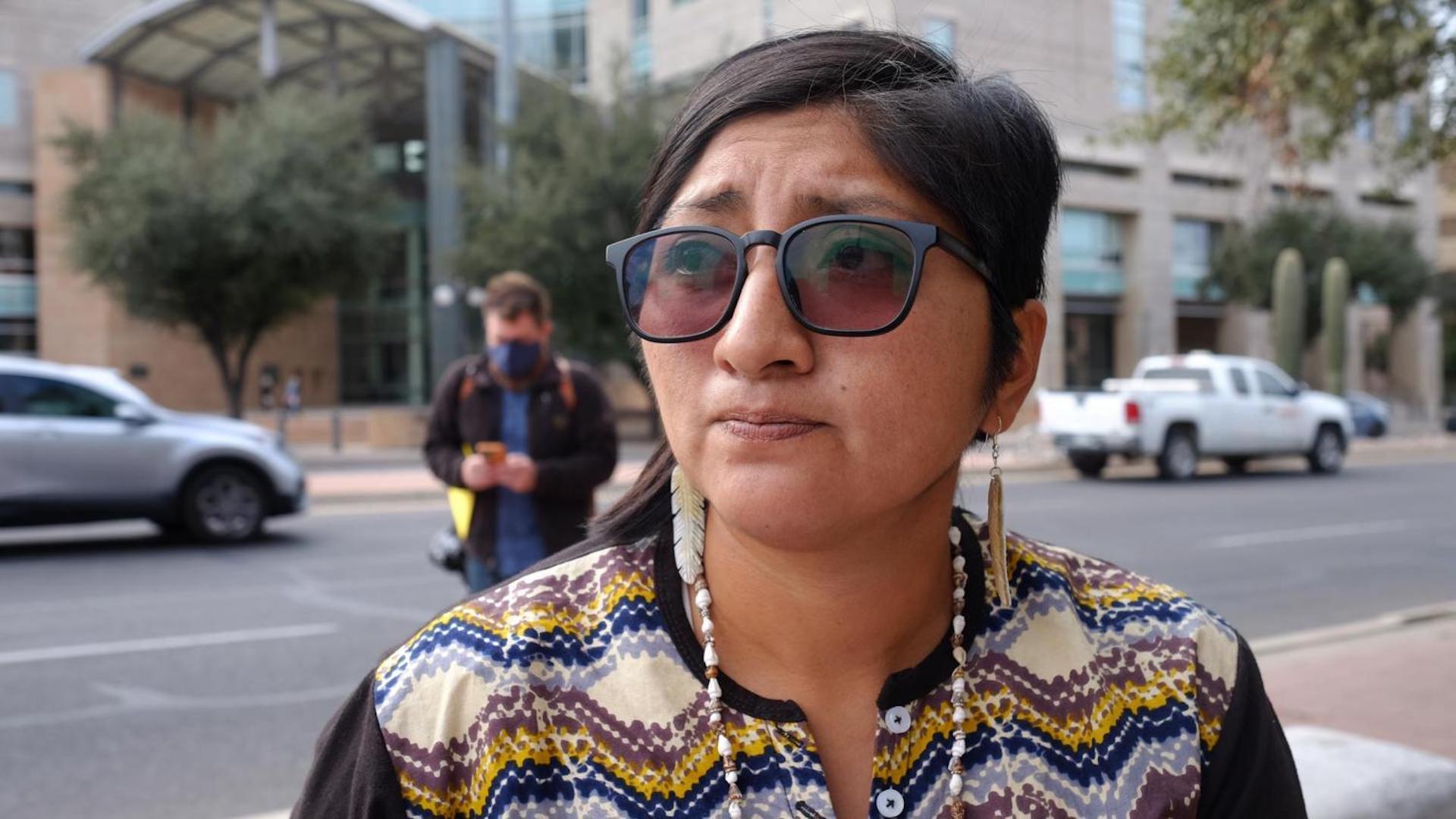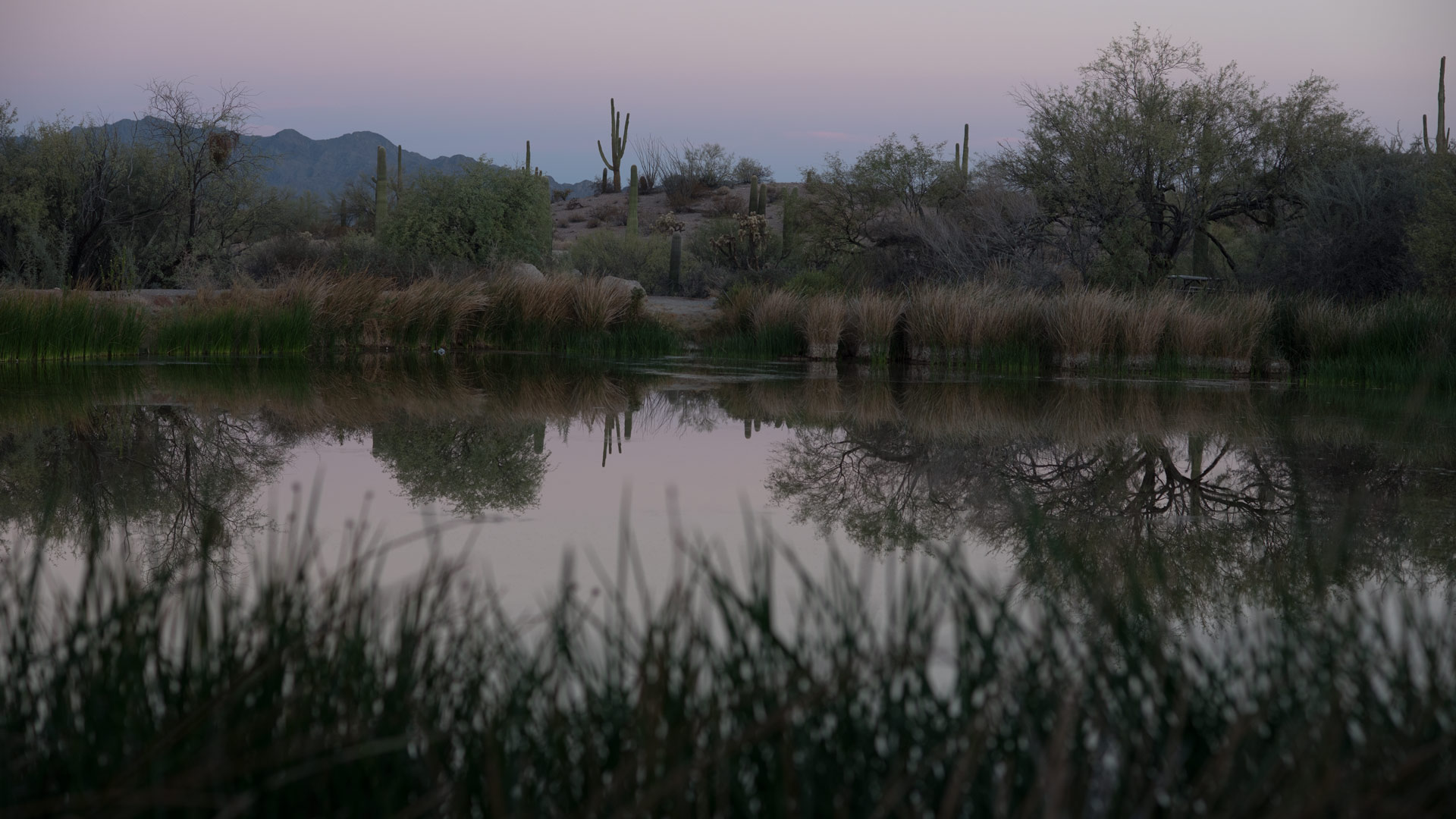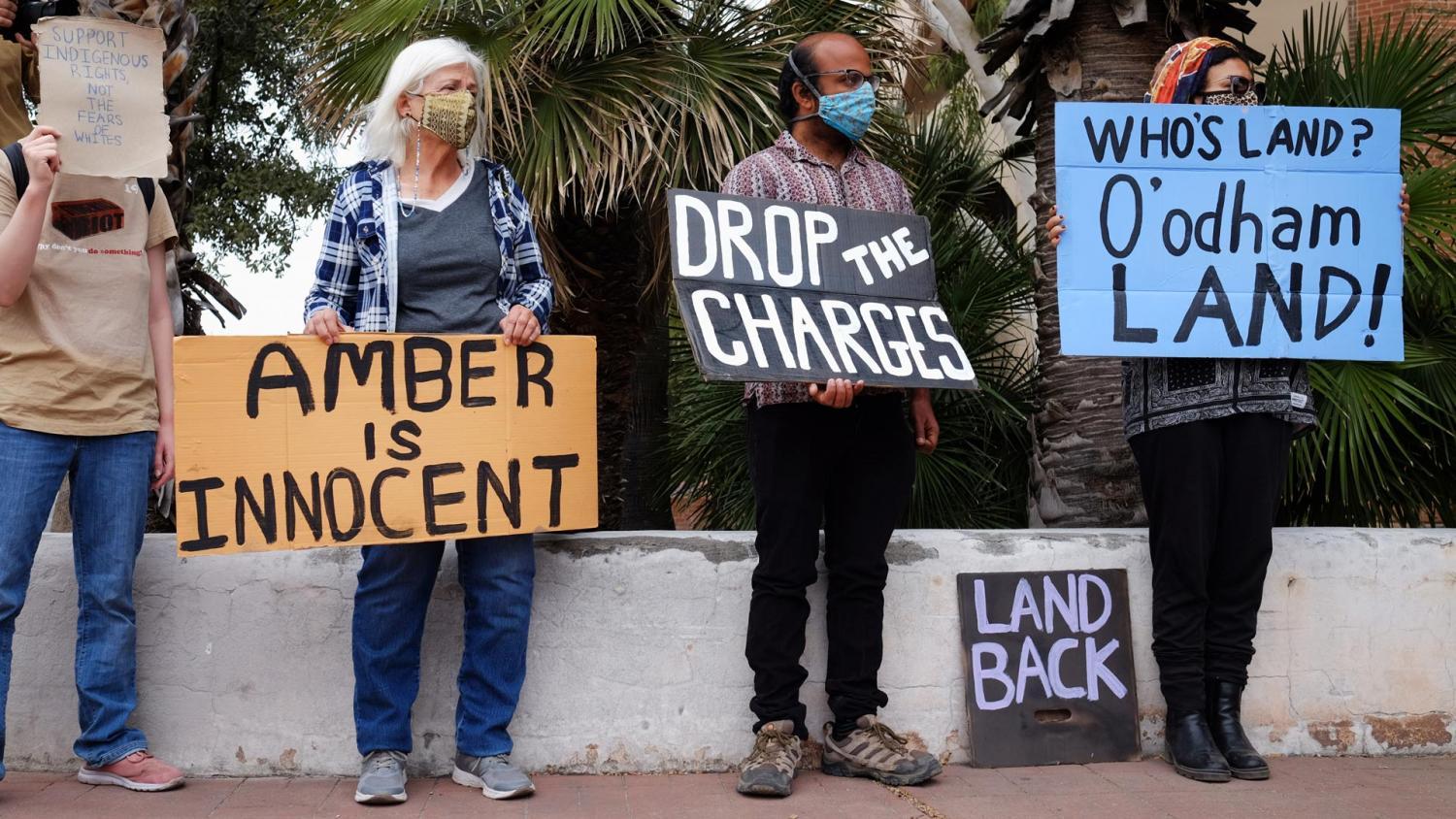 Amber Ortega looks on during a press conference in November 2021 about her case.
Amber Ortega looks on during a press conference in November 2021 about her case.
It has been almost a year since President Joe Biden officially ended his predecessor’s wall project along the U.S.-Mexico border. But a trial continues for one Indigenous protester facing federal charges for blocking construction machinery at a wall site in Organ Pipe Cactus National Monument.
One morning last month, Amber Ortega emerged from the federal courthouse in downtown Tucson to cheers from a small crowd of supporters.
Her trial came just over a year after she and another Indigenous woman were arrested for blocking machinery at a border wall construction site near Quitobaquito Springs, a celebrated water source and biodiversity hotspot in Organ Pipe.
In a video Ortega filmed on her phone that day, she can be heard chanting and singing as almost a dozen national park service officers and Border Patrol agents surround her. A bright yellow construction vehicle used to move dirt is parked behind them.
Ortega’s an enrolled member of the Tohono O’odham Nation and is also Hia C-ed O’odham, a related tribe that’s not recognized by the federal government. Hia C-ed O’odham communities resided at Quitobaquito before the international border was established and families remained there until it was bought by the National Park Service in the 1950s.
Ortega has family buried near the spring. At a press conference after her trial last month, she said the site is an oasis.
 VIEW LARGER Quitobaquito Springs pictured at dawn on Sept. 27, 2020.
VIEW LARGER Quitobaquito Springs pictured at dawn on Sept. 27, 2020. “Quitobaquito is a bird’s nest, it’s a habitat for endangered species,” she said. “The land, that wall, the desecration, it’s pure image of death, it’s pure image of division.”
Ortega took the stand at trial and told the judge she was praying there the morning of Sept. 9, 2020, as she had done more and more frequently as the border wall project made its way across Organ Pipe’s roughly 30-mile border boundary.
When she heard machinery firing up nearby, she said her religious and cultural beliefs as a Hia C-ed O’odham compelled her to the construction site.
“What we did was not planned, what we did was a calling that we heard and answered to that came from our land, that came from our ancestors,” she told press and supporters a few weeks after trial. “For generations, we’ve been fighting for access to our sacred sites, we’ve been fighting for acknowledgement.”
Ortega’s lawyer Paul Gattone argued her actions should be protected under a law forged in the 1990s called the Religious Freedom Restoration Act.
In addition to Ortega’s testimony, he called Hia C-ed O’odham elder and historian Lorraine Eiler as an expert witness to testify to Quitobaquito’s vital importance to the tribe.
“Amber was in what is essentially a church for Indigenous people and was expressing her religious beliefs,” he said.
The same defense was used successfully in Tucson in 2019 by Scott Warren, a humanitarian volunteer with the group No More Deaths who faced up to 10 years in prison on a felony harboring charge and a misdemeanor trespassing charge for providing food and water to migrants traversing the Arizona desert.
Warren testified his faith drove his actions and was acquitted of all changes, in part using the Religious Freedom Restoration Act. Gattone saw an opportunity to make a similar argument for Ortega.
“You know, we were trying something that is real and has been used effectively in other cases,” he said.
But in Ortega’s courtroom, federal prosecutors immediately asked presiding Federal Magistrate Judge Leslie Bowman not to consider any defense that hinged on religious freedom. She said she’d hear all the testimonies and issued a decision two weeks after the trial.
“She decided that the Religious Freedom Restoration Act did apply in the case, but she ruled that we had not met our burden in showing that the government’s actions presented a substantial burden of Amber’s religious exercise or religious freedom," Gattone said.
Religious freedom arguments must prove a person's ability to practice their religion is significantly burdened or made impossible due to government actions.
 Supporters of Amber Ortega hold signs of support during a rally across the street from the federal courthouse in downtown Tucson on Nov. 23, 2021.
Supporters of Amber Ortega hold signs of support during a rally across the street from the federal courthouse in downtown Tucson on Nov. 23, 2021.
David Martinez, an associate professor of American Indian Studies at Arizona State University, says on public land, that barrier can be impossibly high.
“If a substantial burden is created for the tribes as a result of federal development of given public land, coincidentally, then … to put it glibly it’s the cost of doing business,” he said.
Natali Segovia is a lawyer of Peruvian Quechua descent who is the legal director of the Water Protector Legal Collective, an Indigenous-led legal aid network born out of the Standing Rock protests of 2016.
She says faith-based defenses for land protection are often unsuccessful, because courts associate religion with human-made places, like a church.
“It’s something very difficult for courts to wrap their minds around, because it departs from a Christian worldview, where there’s a separation between the land and religious beliefs,” said Segovia. “While the religious freedom rights act has been used successfully by anti-abortion groups and members of the religious right ... when it comes to Indigenous rights and access to sacred sites, there’s consistently been a double standard.”
In Ortega’s case, the judge denied the defense’s religious freedom argument to determine guilt or innocence, but said testimonies could be used to consider her motives.
“I think the court took into account the issues and also really addressed Amber Ortega’s deeply held spiritual beliefs with a great deal of respect,” she said. “It’s something I don’t see as much of.”
Still, many activists wonder why, under a new administration that already canceled border wall construction, Ortega’s case is being prosecuted at all.
Martinez, who is Hia C-ed O’odham and a member of the Gila River Indian Community, worries it sets a dangerous new precedent for those going to Quitobaquito.
“It sends the message to us that we might be in violation of the law by simply going to this place and wanting to protect it,” he said.
But Ortega is resolute. Nellie Jo David, the other Hia C-ed O'odham woman arrested last year in Organ Pipe, told supporters she decided to take a plea deal amid what felt like overwhelming pressure. Ortega says she almost did the same, but she went to trial to show future generations that it’s possible.
“The more we move forward, the more truth we’re able to reveal as Indigenous people to these lands,” she said. “The government can make it’s ruling, but our battle and our stories will continue.”


By submitting your comments, you hereby give AZPM the right to post your comments and potentially use them in any other form of media operated by this institution.